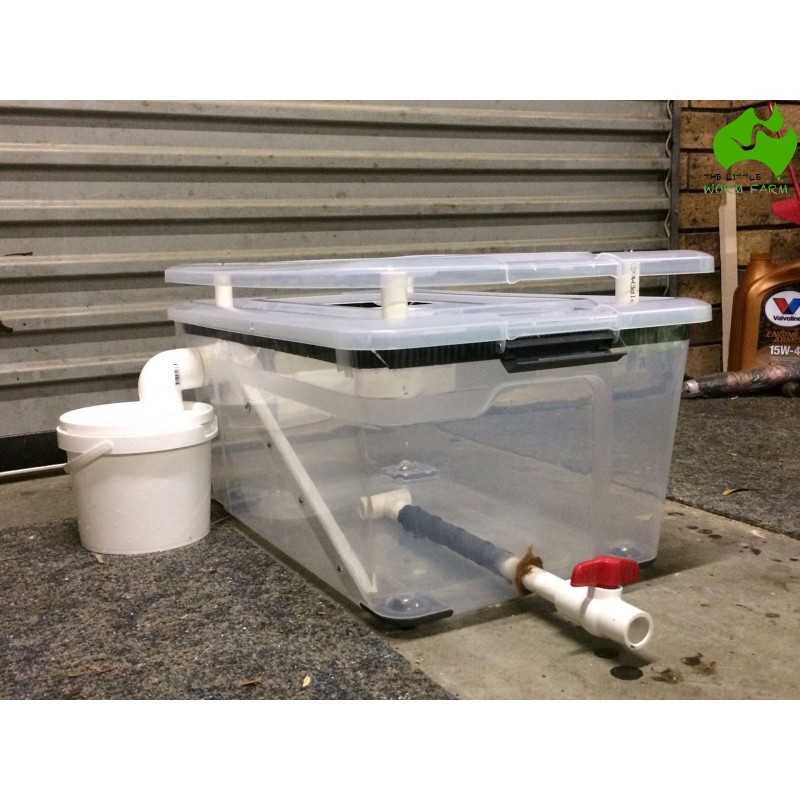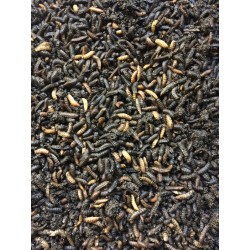You are probably asking what do Black Solider Fly Larvae have to do with a worm farm. First, they are quite a common critter to be found in a worm bin if you live in a country where the weather can be hot enough for them. And second, they can compost food scraps that worms cannot eat and the frass the produce is excellent worm food.
Having composted all my fruits and veggies scraps, I have decided to now take care of food worms cannot eat such as meat, dairy products, fatty food etc... This is why I started investigating and trialing with Black Soldier Fly Larvicomposting.
What are Black Soldier Flies?
Black Soldier Flies (BSF) are very different to the common house flies. Even if they are quite common in your area, I bet you have probably never seen any because they usually stay away from humans and are not attracted by our food as they don't have mouth and thus don't eat. They only drink to hydrate themselves, mate, lay eggs and die. The female BSF oviposit (lay) their eggs in a cluster of 500 to 600 eggs to a dry area adjascent to decomposing but fresh food as opposed to house flies that are attracted to rotten food and would deposit their eggs on the food itself. At no stage of their life are BSF considered pests and they are not vectors of pathogens. In their adult fly stage, they only live for about 8 days.
Black Soldier Fly Larvae
After just four days, the eggs will hatch and very small Black Soldier Fly Larvae (BSFL) will crawl to the food and start their voracious food to biomass conversion (bioconversion). At their best each larva can consume around 1 gram of food scraps per day. So a bin with 5000 of them can consume about 5kg of food scraps per day. That is much faster than compost worms.
In ideal conditions, BSFL will become pupae ready to transform into adult flies in just 15 days. So to insure there is always a decent quantity of larvae in the bin, an egg trap is to be installed inside the bin near the food. Adult females will oviposit eggs in those traps and juvenile larvae will hatch and drop onto the food and the cycle continues.
Conditions for survival
BSFL prefers hot climates and will slow down and hibernate or die if it is too cold. In nature they would bury themselves until the weather warms up.
As opposed to compost worms, BSFL also need a much wetter environment but too much water can also be detrimental as they are also aerobic critters.
Being voracious, enough food should be supplied to them or they will starve once all food scraps have been consumed.
Distinctive traits
At birth, BSFL are white/cream in color. As they grow they will keep that light color until they are close to the last stage where they start being darker and then turn into black pupae ready for transformation.
At the pupa stage, BSFL loose the use of their mouth and cannot eat anymore and this even when they will become adult flies. The pupae will start trying to get out of the environment where they have grown in and start seeking for a drier and safer environment into which they will bury themselves and get ready to transform. This behaviour is an advantage for the BSFL farmer: they can self-harvest into a container outside the composting bin. To acchieve this, the bin is built with a ramp that goes from the bottom of the bin to the top where there will be a whole that leads to the external container. So regularly, the BSFL farmer will see a bunch of black pupae in the harvesting container, the pupae are then collected and given as food for the chicken, fish (pond, aquaponics etc...), fishing bait or just thrown back into the garden to sustain the natural population.
Where a decent population of BSFL has taken over, there are usually less house flies around. Apparently BSF larvae produce pheromones that seem to repel the common house flies and even when house flies deposit their eggs in the BSFL bin, the environment is not suitable for the larvae and most of the time the house flies larvae will hatch when the food has already been eaten by the BSFL.
Other use of BSFL
Black Soldier Fly Larvae are not only amazing composters, there are studies that show that they can be use for much more than just recycling food scraps. I won't go into details yet but here is a short list of what these little critters can be use for:
- waste management
- sewage management
- biofuel production
- animal feed (chooks, reptiles, fish... and even human). BSFL are rich in protein and calcium but low in fat.
- polluted water remediation
My experience with BSFL
As mentioned above, Black Soldier Flies Larvae are the missing link for those who want to divert almost 100% of their food scraps from the landfills. BSFL will eat a lot of food that composting worms won't touch. These little larvae are incredible creatures and recent studies show great potential for future use in bio-fuel, waste management and more. But this will be for another blog post.
Finding eggs and increasing the population
It all started when I found two massive cluster of eggs under the lid of Gargantua, my homemade CFT.
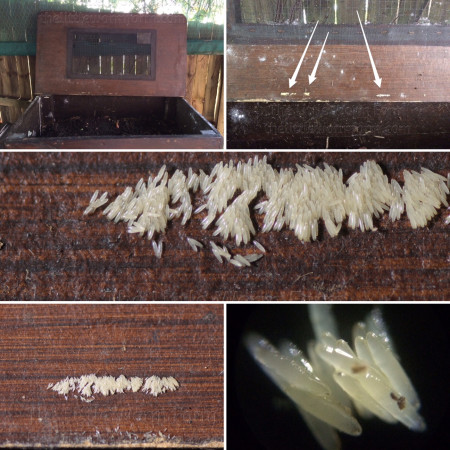
A couple of days before Boxing Day I started a BSFL bin by using the leachate collection tray of a Worm Cafe. I added a bunch of food scraps and deposited the eggs on a piece of dry cardboard. The larvae hatched four days later.
In order to increase the population I needed more eggs. So I had to build an egg trap and some strips of corrugated cardboard will do the work nicely. Adult female flies like to oviposit their eggs on a dry surface adjascent to the food, if the surface has little cavities that is even better. This is why corrugated cardboard is great, the flutes offer an ideal eggs container.
The photos below shows the temporary bin made of a Worm Cafe leachate collection tray. The yellow trap on the back left of the bin is an attempt to control flies and fruit flies that are attracted to the rotting food I've added. As you can see composting with BSFL does not look sexy, you don't get that nice compost like with the worms but it's a thick and naughty frass. At the beginning it also stinks but as the larvae population grows, they would eat the food so fast that it does not have time to rot but in the process, a lot of moisture is released.
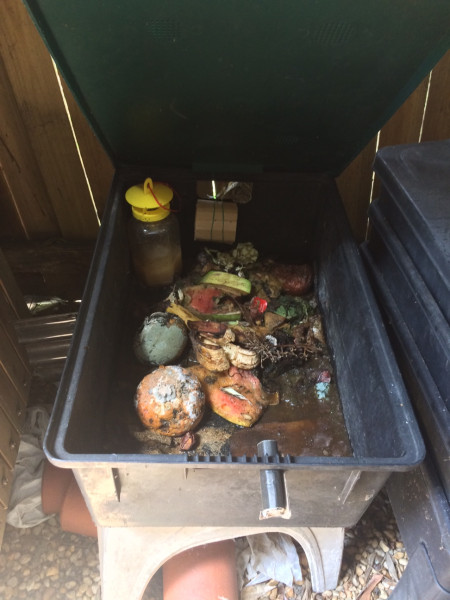
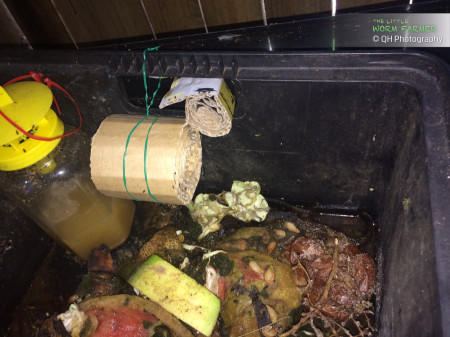
Here is a female Black Soldier Fly depositing her cluster of eggs in the flute of my corrugated cardboard egg trap.
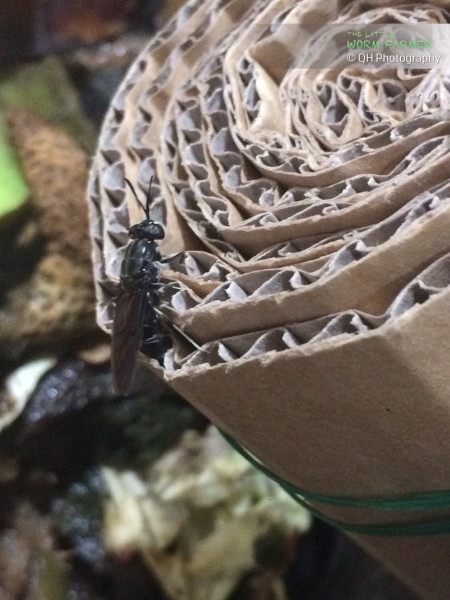
And this is the cluster of eggs (yellow/cream bit in the flute at bottom right).
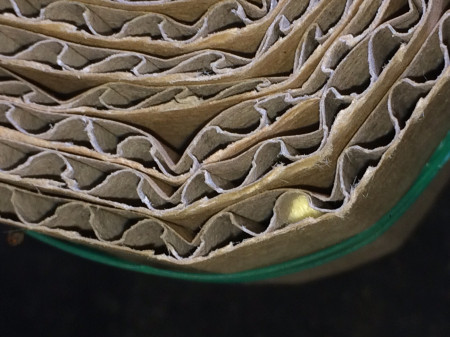
Building a BSFL bin
I then started to build a prototype BSFL bin with a underbed storage tote. The self-harvesting ramp is made of styrofoam cut off from a brocoli box. I painted the tote in black to restrict the light coming in the bin as the BSFL are photophobic.
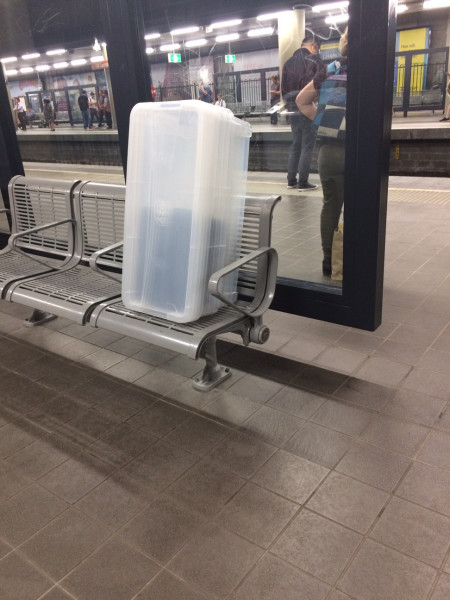
The bin is split in 2 with 1/4 of it being the pupae collection compartment. The two compartments are separated by a block of styrofoam.

The prototype is then installed outside with the worm bins. I then emptied the temporary bin into the prototype and also attached the egg trap to the lid which is attached to the tote with two hinges. Food is added on the surface and in the empty pupae collection compartment (back of the tote) I added about 2" of vermicompost: when the pupae will reach this area, they will find the dry compost and will settle and bury themselves in it.

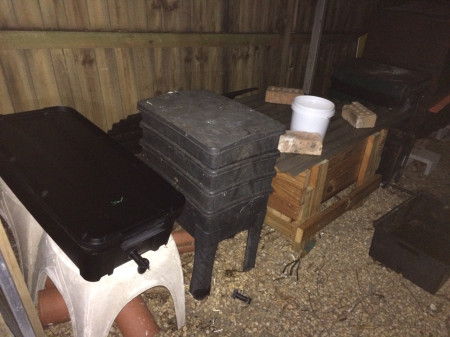
In just three weeks, I have collected enough eggs that gave birth to a lot of little larvae and some have become pupa and managed to find their way to the harvesting area where they buried themselves down in the vermicompost.
Here is an empty pupa shell, the fly has already emerged.
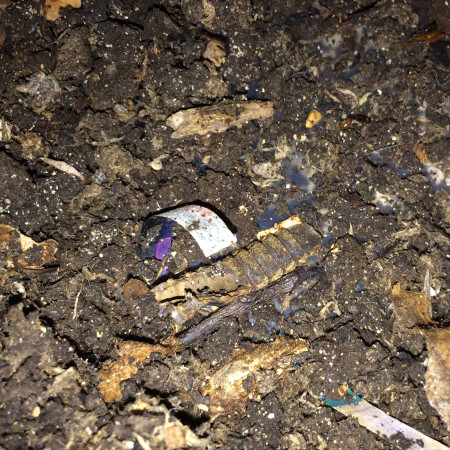
These are two pupae that have just landed on the vermicompost in the collection compartment.
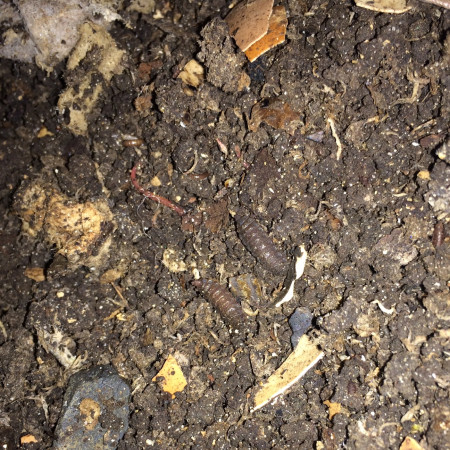
Some early results
And although they are not at their biggest size yet, the larvae are already showing a high speed of food consumption. The video below shows how much they have eaten some rice noodles I gave them in just 10 hours.
As a second test I added two prawns and a beef steak (from a BBQ at the beach that has been extended and the food turned bad...).
One day I found a Garden Soldier Fly that I took for a Black Soldier Fly. I took a series of photograph you can see on my Facebook Page: Female Garden Soldier Fly
Here is a comparison photo between the two species:
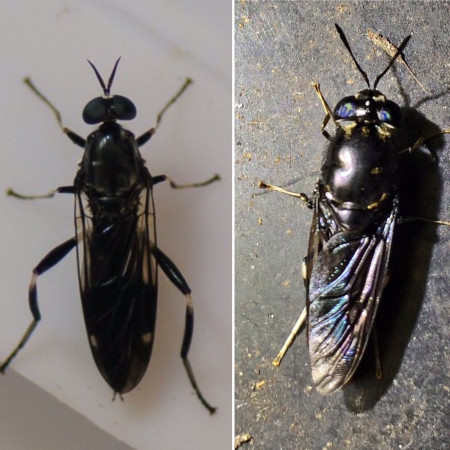
On my next post I will talk about the next bin I'm currently working on. Meanwhile if you are interested in BSFL and want to learn more, come join me in the Black Soldier Fly - BSFL Facebook Group
Posted
in
A day in a worm farm, Black Soldier Fly Larvae on Jan 16, 2017
by Quoc-Huy Nguyen Dinh
